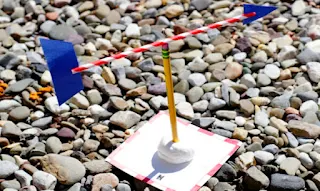Search This Blog
Learning ideas for parents and caregivers educating toddlers and little homeschoolers!
Featured
- Get link
- X
- Other Apps
Nature Study: Weather Instruments for Kids!
 |
| All in One Weather Station Sold at Walmart |
1. Thermometer
i. What is it? A thermometer measures temperature.
ii. How it works: Mercury or alcohol expands and contracts in a tube as the temperature changes, indicating the temperature on a scale.
iii. For kids: Explain how temperature affects how we feel (e.g., hot or cold) and how it influences the weather.
iv. Public Places: Weather stations, science museums, and some parks may have large outdoor thermometers visible to the public.
2. Anemometer
i. What is it? An anemometer measures wind speed and direction.
ii. How it works: Cups on arms catch the wind and rotate, which is then converted into a speed measurement.
iii. For kids: Discuss how wind affects weather patterns and how different wind speeds feel.
iv. Public Places: Weather stations often have visible anemometers on tall poles or rooftops.
3. Rain Gauge
i. What is it? A rain gauge measures the amount of rainfall.
ii. How it works: Rainwater collects in a tube or cylinder, and the height of the water indicates rainfall.
iii For kids: Teach them about precipitation and how rain is essential for plants and ecosystems.
iv. Public Places: Some parks or botanical gardens may have visible rain gauges for educational purposes.
 |
| Barometer for sale on Amazon |
4. Barometer
i. What is it? A barometer measures air pressure.
ii. How it works: Changes in air pressure cause a column of mercury or aneroid capsule to move, indicating pressure changes.
iii. For kids: Explain how air pressure affects weather patterns and how a barometer can predict weather changes.
iv. Public Places: Weather stations and some science museums may have barometers on display.
 |
| DIY Window Vane from PBS.org |
5. Weather Vane
i. What is it? A weather vane, also called a wind vane, shows the direction of the wind.
ii. How it works: The vane, often shaped like an arrow, points in the direction from which the wind is blowing.
iii. For kids: Help them understand cardinal directions and how wind direction influences weather patterns.
iv. Public Places: Weather vanes can be found on top of buildings, especially older structures like barns or churches, and are often visible from a distance.
6. Hygrometer
i. What it measures: Humidity (amount of moisture in the air)
ii. How it works: A hygrometer uses a material that expands and contracts with changes in humidity. By measuring the expansion or contraction, it determines the humidity level.
iii. Activity: Make a hygrometer using a strand of hair and a small container. Attach one end of the hair to a weight and the other end to a pointer. As humidity changes, observe how the hair lengthens or shortens, moving the pointer.
iv. Public Places: Weather stations, Observatories, Meteorology Department of an Educational Institution, Science museums, and Science Fairs are some places that may have hygrometers visible to the public.
Take Away
Introducing children to weather instruments not only teaches them about the science behind weather but also encourages curiosity and observation skills. Exploring these instruments in public places can make learning hands-on and exciting. Whether it's visiting a weather station or observing a weather vane atop a building, there are plenty of opportunities for children to engage with weather science in their everyday surroundings.
Remember to supervise children around weather instruments in public places and encourage them to ask questions and explore further on their own.
Have fun exploring and learning together!
- Get link
- X
- Other Apps
Popular Posts
The Wild Robot Movie vs. The Wild Robot Book
- Get link
- X
- Other Apps
🇨🇦 100 Field Trip Ideas for Kids Manitoba
- Get link
- X
- Other Apps

.jpg)




Comments
Post a Comment